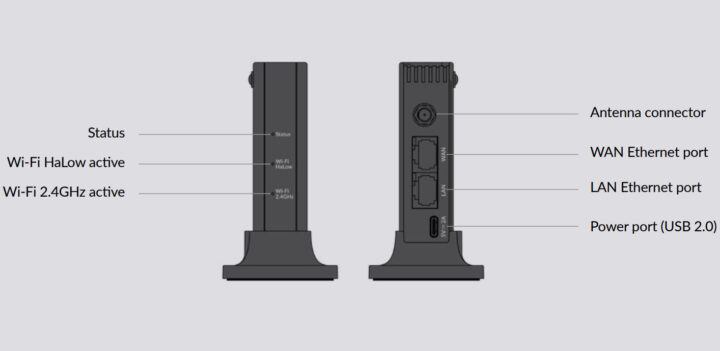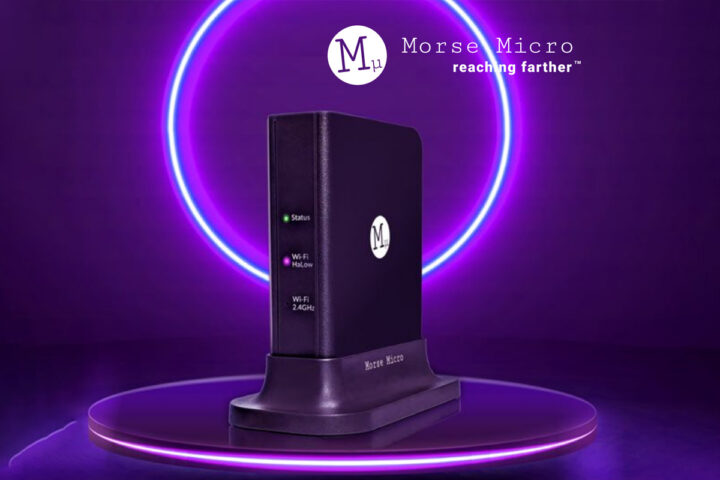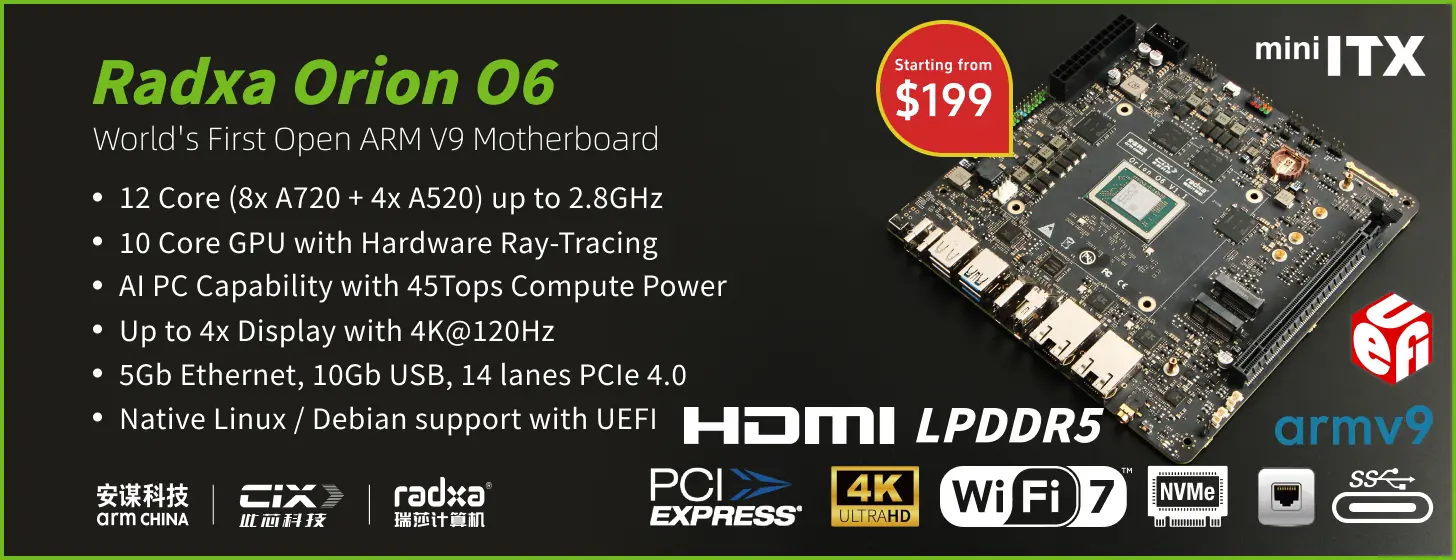Morse Micro in collaboration with GL.iNet has recently showcased the HaLowLink 1 Wi-Fi HaLow gateway, which the company terms as Wi-Fi HaLow reference design and evaluation platform developed for long-range, low-power wireless connectivity for IoT applications. Built around the AzureWave AW-HM593 module with Morse Micro MM6108 silicon, it supports 1/2/4/8 MHz bandwidths.
It features a MediaTek MT7621A dual-core CPU, Wi-Fi 4 module, dual Gigabit Ethernet, USB-C, and an SMA antenna connector, allowing it to work as a Wi-Fi HaLow router, access point, or extender. The device runs OpenWrt and provides an intuitive web-based UI and SSH/CLI configuration. OpenWrt also gives access to a web-based UI and SSH/CLI configuration. These features make this device useful for applications like smart homes, industrial automation, agriculture, and telecommunications.
HaLowLink 1 specifications:
- SoC – Mediatek MT7621 dual-core, quad-thread MIPS1004K processor @ up to 880MHz
- System Memory – 256MB DDR3 (optional 512 MB)
- Storage – 32MB NAND Flash
- Connectivity
- Wi-Fi HaLow (802.11ah)
- AzureWave AW-HM593 module with Morse Micro MM6108 HaLow chipset supporting Wi-Fi HaLow, IEEE 802.11ah, Sub-GHz, 32.5 Mbps, ultra-low power, WPA3
- Sub-GHz frequency range (750 MHz – 950 MHz, region-dependent)
- Supports 1/2/4/8 MHz bandwidth modes
- Up to 23 dBm output power
- Range – Up to 1 km in urban environments, 3+ km in open areas
- 802.11s Mesh and EasyMesh support
- Supports HaLow Station (STA) and Access Point (AP) modes
- Wi-Fi
- 2.4 GHz Wi-Fi (802.11n)
- Can act as a bridge between Wi-Fi HaLow and traditional Wi-Fi networks
- Ethernet
- 2x Gigabit Ethernet (1x WAN, 1x LAN), 2×2 (supports MIMO dual-stream operation)
- Supports Virtual Wire Mode for legacy Ethernet devices
- Wi-Fi HaLow (802.11ah)
- USB – 1x USB-C port can be used as power and network access
- Misc
- Status LED, Wi-Fi HaLow LED, Wi-Fi 2.4 GHz LED, SMA antenna connector
- Power Supply – 5V power via USB-C
- Dimensions – 88 × 68 × 24mm
- Certifications – FCC & IC certified
In terms of software, the HaLowLink 1 runs OpenWrt-based firmware, giving access to a web-based user interface for easy configuration, along with SSH and command-line access for advanced users. Additional tools such as ping, traceroute, iperf3, and arp-scan allow for real-time diagnostics and network monitoring. As this router uses OpenWrt you can always install additional OpenWrt packages, to get your desired functionality.
The router can extend the range of existing Wi-Fi networks, connect non-HaLow devices via Ethernet or 2.4 GHz Wi-Fi, and even act as a virtual wire replacement for Ethernet cables.

We first wrote about 802.11ah low-power long-range WiFi standard operating at 900 MHz in 2014, but adoption of this technology was slow. We’ve still seen products released over the years, but not quite as many as expected, and in recent months we’ve covered the Morse Micro MM8108 and Murata’s LBWA0ZZ2HK and LBWA0ZZ2HL. We have also written about the STK-AH9066 WiFi HaLow gateway and AP7688-WHM WiFi HaLow gateway similar to the HaLowLink 1 and designed to expand the range of wireless connectivity by several hundred meters. Other Wi-Fi HaLow-based products include the MM6108-EKH05 Wi-Fi HaLow Evaluation Kit, the Vantron HCAM26 IP camera, and the LILYGO T-Halow a low-cost ESP32 powred dev board designed for security cameras, wildlife cameras, monitoring and other low-power applications.
The HaLowLink 1 Wi-Fi HaLow gateway can be purchased from Mouser for $99.00. More information about the product can be found on its product page and the product brief.
Debashis Das is a technical content writer and embedded engineer with over five years of experience in the industry. With expertise in Embedded C, PCB Design, and SEO optimization, he effectively blends difficult technical topics with clear communication
Support CNX Software! Donate via cryptocurrencies, become a Patron on Patreon, or purchase goods on Amazon or Aliexpress






What’s going to be the knock-on impact for LoRa / Meshtastic?
Supported regions mentioned are only – USA, Canada, Australia from the pdf documentation
For now… Also, Meshtastic is quite popular in those places – particularly in response to natural disasters!
I don’t know that there will be a major impact for lora (or by extension – meshtastic) at this time.
Lora and Halow are ultimately different things that have room to coexist. Lora is lower power and longer range than Halow, but it’s just a plain packet radio with a very very low data rate. WiFi Halow may be longer range than 2.4/5/6ghz wi-fi’s are but it is still a lot shorter range than lora (timing windows prevent >10 miles even being possible in Halow regardless of transmit power), it has a much higher data rate and of course is a full blown IP network.
There may be roles where Halow might work nicely and folk were using meshtastic before, but ultimately they’re doing very different things and are only similar in their frequency band. Id liken it more to the difference between Bluetooth and WiFi both being on 2.4ghz, as is your domestic microwave, and none of those 3 displace one another.
WiFi HaLow is better suited to higher bandwidth applications like cameras. I don’t think it’s quite as low power as LoRa, so I don’t see any impact on Meshtastic if only messaging and GPS coordinate sharing are needed.
There’s an interesting comparison here (but written by Morse Micro’s CEO so expect potential COIs): https://www.mwrf.com/technologies/embedded/systems/article/21268718/morse-micro-whats-the-difference-between-wi-fi-halow-and-lorawan but with regard to LoRaWAN’s security, they fail to mention DASH7 over LoRaWAN.
Anyway, the concerns regarding potential conflict with LoRa/Meshtastic stem from NextNav’s application to the FCC: https://www.rfidjournal.com/news/hundreds-weigh-in-on-fcc-nextnav-petition-for-900-mhz-band-change/221647/
The Wi-Fi alliance say that while HaLow has higher instant power draw than LoRa, since it transmits much quicker, overall it actually uses less power. No idea how true that is, and in what exact circumstances. It would be interesting to have a real-life comparison with actual measures in a number of scenarios. For now I have to admit I’m a lot less confident in HaLow really being suitable for low-cost very-low power devices, but it seems difficult to find any reasonable and well documented figures.
Did my reply comment to Callum King-Underwood get removed because of the hyperlinks?!
I think sometimes comments remain pending until they are validated by an admin, and with the timezone difference…
Strange…it appeared visible shortly after I posted it and then when I later saw there were subsequent replies I found it was no longer visible! Since it’s now visible again, it looks like I posted it in reply to Jean-Luc rather than Callum…
Jacques is right. It was in the moderation queue.
Also surprised GL.iNet went with main OpenWRT over the LibreCMC fork
librecmc doesn’t support ralink/mediatek – only ancient/almost EOL ath79 architecture
AH that makes more sense! Thanks for the clarification…
LibreCMC support only hardware that can run with just free and open source software. It does not support hardware that require closed source software.
Its not ‘ancient’. Its the opposite. Its highly modern to respect the user freedom these days.
Couldn’t agree more with your sentiment but I guess @gigi meant that the supported hardware specifically is (relatively speaking) “ancient”.